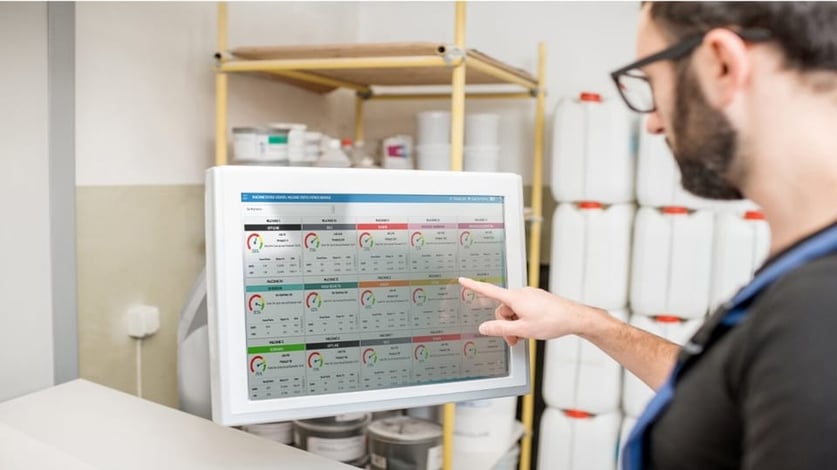SYSCON PlantStar BLOG
MES 101: Learn the Basics of Manufacturing Execution Systems Part 2
Mar 26, 2021 5:00:00 PM / by David Crowley

In our first series of MES 101 we discussed what is an MES and the basics of a manufacturing system. In part 2 we will dig deeper into the core functions and benefits that a manufacturing execution system can play within your environment.
As a quick recap on MES 101 part 1, here's a quick summary on the basics of MES:
A Manufacturing Execution System (MES) is an information system which monitors and tracks the process of producing manufactured goods on the factory floor. The overall goal of MES is to make certain that manufacturing operations are effectively executed to improve production output. An MES helps achieve that goal by tracking and gathering accurate, real-time data about the complete production lifecycle, beginning with order release until the product delivery stage for finished goods.
Enterprise Resource Planning (ERP) versus Manufacturing Execution Systems (MES)
What makes the MES system important is that it serves as a functional layer between the ERP and the process control systems on the factory floor, giving manufacturers real-time workflow visibility, flexibility, and insight into how best to improve enterprise-wide manufacturing operations.
- ERP– Helps you manage and create your basic schedules for production, along with material use, your deliveries, and shipments, and gathering information about your business.
- MES– Helps you manage your shop-floor manufacturing operations, as well as reporting on production line activities in real-time. MES manufacturing has real-time features, to help you control all aspects of your shop floor including: Inventory, Operators, Machines, and support services, all from a variety of dashboards. An MES will communicate up and down the chain involving machines, stations, equipment, AND people.
Before we go further into this discussion, try answering these questions below:
- Do you know how long it takes to make your product from start to finish?
- Can you accurately predict when your next product shipment will be ready?
- Can you identify and categorize your scrap in real-time?
- Do you know immediately when a machine is down?
- Do you know immediately when one of your machines has a increase in rejected parts?
- Do you have a system to track and schedule Preventive Maintenance?
- Do you know immediately when you have a Process alert?
- Do you immediately know your OEE on every machine?
- Are you monitoring every shot on every machine? Are you tracking net pieces and your standard rate versus actual?
- Are you still using paper, clipboard, dry erase boards for your manufacturing key performance indicators?
- Have you been able to increase production output?
- Are you waiting until end of shift or end of day to analyze your production summary?
- Can you answer all customer questions about the products you send them?
- Is everyone within your plant striving to achieve the same goal?
I think you see where we are headed here. There is fantastic opportunity here to gain valuable ROI when looking at a MES to provide detailed answers to these questions in real-time to better operate while reducing a large area of labor costs.
Let's dig a little deeper and go through some of the Core functions of a Manufacturing Execution System
- Data Collection - Collect valuable information on your production lines, so you can improve your manufacturing processes. Display real-time key performance indicators on manufacturing dashbaords throughout your facility.
- Managing Your Labor Force - Easily manage your staff and even equipment from the shop floor to maximize their utility.
- Product Traceability - Effortlessly track your production progress and see the status of operations in real-time.
- Quality Control - Perform quality checks in real-time, helping to address production variations and enhance product quality.
- Performance Analysis and Alerts - Visualize the entire production process, gaining insight into areas where productivity is lagging expectations. View your OEE by every machine in your factory on a dashboard that can be viewed from any device. Monitor every shot of the machine and view real-time process summary. Set up your product standards to automatically set thresholds specific to each job. Create email and text alerts to quickly notify key personnel when a process tolerance is exceeded from lower or upper limits or create a Overlay Profile with up to 500 data points produced with every shot.
- Maintenance Management - Perform predictive maintenance to avoid unplanned downtime which interrupts your production flow.
- Employee Training - Access saved documents, training videos, part images, etc, right from the shop floor.
- Operator Tracking - Utilize your MES system to see all interactions from the shop floor as well as see when operators are logged in and out of certain work areas within your factory.
- Other added functions - Tool life tracking, labor tracking, label printing, job scheduling, ERP integration, material tracking, and the ability to utilize process monitoring (collect and monitor process variable data).
Top Manufacturing Execution System Vendors
When choosing a vendor to meet your manufacturing needs and provide you with all the functions and benefits of a manufacturing execution system, look for EXPERIENCE. With over 50 years of experience with helping people in manufacturing SYSCON PlantStar has all the capability to catapult you to your MES system goals. SYSCON PLANTSTAR is very price competitive due to its proprietary MES hardware and years of experience when integrating all types of machinery and equipment. Experience with Machine interfaces, Digital and Analog interfaces and OPC-UA are crucial when selecting an MES provider so you rest assure they can integrate with any piece of equipment in your facility.
Still have questions? Visit our FAQ to review and learn more!
To see the next post in our MES 101 series and get more information about how an MES solution can benefit your business, subscribe to our BLOG!
Subscribe to Email Updates
Posts by Topic
- Manufacturing Execution Systems (34)
- manufacturing solutions (16)
- MES 101 (12)
- Industry 4.0 (10)
- improve efficiency (9)
- mes software (9)
- mes solutions (9)
- Plastic Molding (8)
- Plastics Technology (8)
- Shop Floor Production (8)
- MES hardware (7)
- digital transformation (7)
- Reduce scrap (6)
- data-driven-decisions (6)
- lean manufacturing (6)
- process monitoring (5)
- product quality (5)
- Medical molding (4)
- lights-out manufacturing (4)
- manufacturing dashboard (4)
- production monitoring (4)
- Shop Floor Safety (3)
- supply chain management (3)
- ERP integration (2)
- Injection Molding Technology (2)
- defect collection (2)
- machine mes (2)
- process variables (2)
- digital strategy (1)
- labor gap (1)
- throughput (1)



